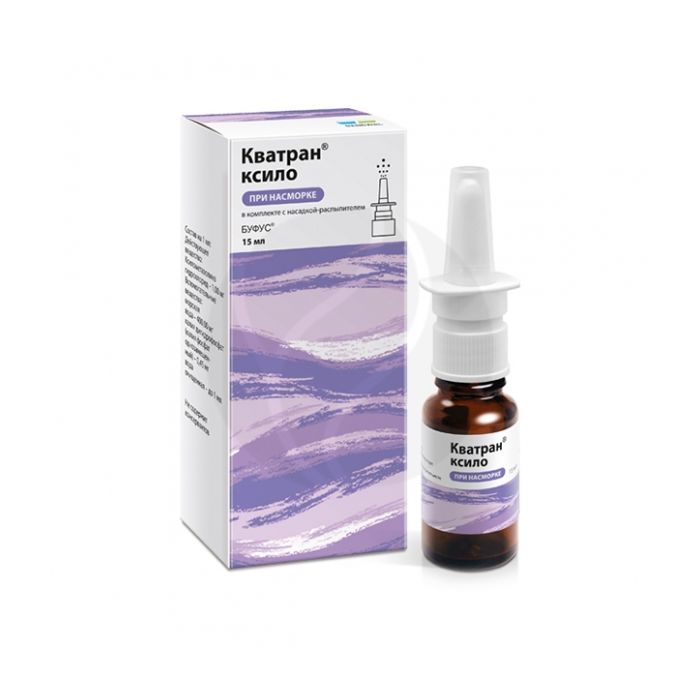Quatran xylo drops with a spray nozzle 0.1%, 15ml
Expiration Date: 05/2027
Russian Pharmacy name:
Кватран ксило капли с насадкой распылетелем 0,1%, 15мл
Х Acute respiratory diseases (ARI) with symptoms of rhinitis (runny nose);
Х Acute allergic rhinitis;
Х Sinusitis;
Х Pollinosis;
Х Otitis media (to reduce swelling of the nasopharyngeal mucosa);
Х Preparing the patient for diagnostic manipulations in the nasal passages.
Intranasally.
Nasal drops 0.1%
Adults and children over 6 years old - 1-2 drops in each nasal passage up to 3 times a day.
It is not recommended to use the drug for more than 5-7 days.
After completion of therapy, the drug can be re-prescribed only after a few days.
For the duration of use in children, you should consult your doctor.
If after treatment there is no improvement or symptoms worsen, or new symptoms appear, you should consult your doctor.
Use the drug only according to the indications, the route of administration and the doses indicated in the instructions.
Composition for 1 ml
Active substance:
Xylometazoline hydrochloride - 1.00 mg
Excipients:
sea ??water - 400.00 mg
potassium dihydrogen phosphate (monobasic potassium phosphate) - 0.45 mg
purified water - up to 1 ml
Hypersensitivity, arterial hypertension, tachycardia, severe atherosclerosis, glaucoma, atrophic rhinitis, condition after transsphenoidal hypophysectomy, inflammatory diseases of the skin or mucous membrane of the vestibule of the nose, thyrotoxicosis, pregnancy, surgical interventions on the meninges (in the history of children (before age 2) for nasal drops 0.05%; up to 6 years - for nasal drops 0.1%).
Do not use during therapy with monoamine oxidase (MAO) inhibitors and tricyclic and tetracyclic antidepressants, other local vasoconstrictor agents (decongestants), as well as with other drugs that increase blood pressure.
Carefully
With hypersensitivity to adrenergic drugs, accompanied by insomnia, dizziness, arrhythmia, tremor, increased blood pressure, porphyria, hyperthyroidism, pheochromocytoma, coronary heart disease (angina pectoris), prostatic hyperplasia, diabetes mellitus, breastfeeding period.
Application during pregnancy and during breastfeeding
If it is necessary to use the drug during pregnancy and lactation, you should consult your doctor in order to assess the ratio of benefits to the mother and the potential risk to the fetus / infant.
Pharmacodynamics
Xylometazoline belongs to the group of local vasoconstrictor agents (decongestants) with alpha-adrenomimetic action, it causes narrowing of the blood vessels of the nasal mucosa, eliminating edema and hyperemia. Facilitates nasal breathing with rhinitis. The effect of the drug occurs within a few minutes after its application and lasts for 12 hours.
Sea water, which is part of the drug as an auxiliary component, helps to maintain the normal physiological state of the nasal mucosa, which makes it possible to reduce the symptoms of irritation and dryness that occur with prolonged use of xylometazoline.
Pharmokinetics
When applied topically, xylometazoline is practically not absorbed, plasma concentrations are so small that they cannot be determined by modern analytical methods.
Overdose
Symptoms: increased side effects.
Treatment: symptomatic.
Side effects
With frequent and / or prolonged use - irritation and / or dryness of the nasopharyngeal mucosa, burning, tingling, sneezing, hypersecretion.
Rarely - swelling of the nasal mucosa, palpitations, tachycardia, arrhythmias, increased blood pressure,
headache, vomiting, insomnia, visual impairment; depression (with long-term use of high doses).
Special conditions
Before use, you must clean the nasal passages.
The recommended doses should not be exceeded, especially in children and the elderly.
Should not be used for more than 7 days, unless the doctor has recommended a different duration of treatment. If after this time the symptoms persist, it is necessary to consult a doctor.
Influence on the ability to drive vehicles, mechanisms
The drug in the recommended doses does not affect the rate of reactions when driving or operating other mechanisms.
Drug interactions
Incompatible with monoamine oxidase (MAO) inhibitors and tricyclic antidepressants.

